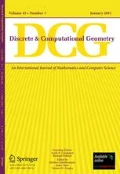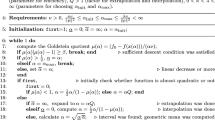Abstract
Let P be a closed simple polygon with n vertices. For any two points in P, the geodesic distance between them is the length of the shortest path that connects them among all paths contained in P. The geodesic center of P is the unique point in P that minimizes the largest geodesic distance to all other points of P. In 1989, Pollack et al. (Discrete Comput Geom 4(1): 611–626, 1989) showed an \(O(n\log n)\)-time algorithm that computes the geodesic center of P. Since then, a longstanding question has been whether this running time can be improved. In this paper we affirmatively answer this question and present a deterministic linear-time algorithm to solve this problem.







Similar content being viewed by others
References
Aronov, B.: On the geodesic Voronoi diagram of point sites in a simple polygon. Algorithmica 4(1–4), 109–140 (1989)
Aronov, B., Fortune, S., Wilfong, G.: The furthest-site geodesic Voronoi diagram. Discrete Comput. Geom. 9(1), 217–255 (1993)
Asano, T., Toussaint, G.: Computing the geodesic center of a simple polygon. Technical Report SOCS-85.32, McGill University (1985)
Bae, S.W., Korman, M., Mitchell, J.S.B., Okamoto, Y., Polishchuk, V., Wang, H.: Computing the L1 geodesic diameter and center of a polygonal domain. In: Ollinger, N., Vollmer, H. (eds) 33rd Symposium on Theoretical Aspects of Computer Science (STACS 2016). Leibniz International Proceedings in Informatics (LIPIcs), vol. 47, pp. 14:1–14:14. Schloss Dagstuhl–Leibniz-Zentrum fuer Informatik, Dagstuhl (2016). ISBN 978-3-95977-001-9
Bae, S.W., Korman, M., Okamoto, Y.: The geodesic diameter of polygonal domains. Discrete Comput. Geom. 50(2), 306–329 (2013)
Bae, S.W., Korman, M., Okamoto, Y.: Computing the geodesic centers of a polygonal domain. In: Computational Geometry: Theory and Applications. Special issue of selected papers from the 26th Canadian Conference on Computational Geometry (CCCG’14) (2015) (in press)
Bae, S.W., Korman, M., Okamoto, Y., Wang, H.: Computing the \({L}_1\) geodesic diameter and center of a simple polygon in linear time. Comput. Geom. 48(6), 495–505 (2015)
Chazelle B.: A theorem on polygon cutting with applications. In: Proceedings of FOCS, pp. 339–349 (1982)
Chazelle, B.: Triangulating a simple polygon in linear time. Discrete Comput. Geom. 6(1), 485–524 (1991)
Djidjev, H., Lingas, A., Sack, J.-R.: An \(O(n\log n)\) algorithm for computing the link center of a simple polygon. Discrete Comput. Geom. 8, 131–152 (1992)
Edelsbrunner, H., Mücke, E.P.: Simulation of simplicity: A technique to cope with degenerate cases in geometric algorithms. ACM Trans. Graph. 9(1), 66–104 (1990)
Guibas, L., Hershberger, J., Leven, D., Sharir, M., Tarjan, R.E.: Linear-time algorithms for visibility and shortest path problems inside triangulated simple polygons. Algorithmica 2(1–4), 209–233 (1987)
Harborth, H., Möller, M.: The Esther-Klein-problem in the projective plane. Inst. Mathematik, TU Braunschweig (1993)
Harel, D., Tarjan, R.E.: Fast algorithms for finding nearest common ancestors. SIAM J. Comput. 13(2), 338–355 (1984)
Hershberger, J., Suri, S.: Matrix searching with the shortest-path metric. SIAM J. Comput. 26(6), 1612–1634 (1997)
Ke, Y.: An efficient algorithm for link-distance problems. In: Proceedings of the Fifth Annual Symposium on Computational Geometry, pp. 69–78. ACM, Saarbrücken (1989)
Lee, D.-T., Preparata, F.P.: Euclidean shortest paths in the presence of rectilinear barriers. Networks 14(3), 393–410 (1984)
Matoušek, J.: Approximations and optimal geometric divide-and-conquer. In: Proceedings of the Twenty-Third Annual ACM Symposium on Theory of Computing, pp. 505–511. ACM, New York (1991)
Matoušek, J.: Approximations and optimal geometric divide-and-conquer. J. Comput. Syst. Sci. 50(2), 203–208 (1995)
Matoušek, J.: Lectures on Discrete Geometry, Graduate Texts in Math, vol. 212. Springer, New York (2002)
Megiddo, N.: On the ball spanned by balls. Discrete Comput. Geom. 4(1), 605–610 (1989)
Mitchell, J.S.B.: Geometric shortest paths and network optimization. In: Sack, J.R., Urrutia, J. (eds.) Handbook of Computational Geometry, pp. 633–701. Elsevier, Amsterdam (2000)
Nilsoon, B.J., Schuierer, S.: Computing the rectilinear link diameter of a polygon. In: Computational Geometry—Methods, Algorithms and Applications, pp. 203–215. Springer, Berlin (1991)
Nilsoon, B.J., Schuierer, S.: An optimal algorithm for the rectilinear link center of a rectilinear polygon. Comput. Geom. 6, 169–194 (1996)
Pollack, R., Sharir, M., Rote, G.: Computing the geodesic center of a simple polygon. Discrete Comput. Geom. 4(1), 611–626 (1989)
Suri, S.: Minimum link paths in polygons and related problems. PhD Thesis, Johns Hopkins University (1987)
Suri, S.: Computing geodesic furthest neighbors in simple polygons. J. Comput. Syst. Sci. 39(2), 220–235 (1989)
Turán, P.: On an extremal problem in graph theory. Matematikai és Fizikai Lapok 48(436–452), 137 (1941)
Acknowledgments
H.-K. Ahn and E. Oh: Supported by the NRF Grant 2011-0030044 (SRC-GAIA) funded by the Korea government (MSIP). M. K. was supported in part by the ELC Project (MEXT KAKENHI Nos. 12H00855 and 15H02665).
Author information
Authors and Affiliations
Corresponding author
Additional information
Editor in Charge: János Pach
Appendix: Bounding the VC Dimension
Appendix: Bounding the VC Dimension
In this section we provide the proof of Lemma 6.3. That is, we want to prove that the set system \(({\mathcal C_R}, \varphi )\) has constant VC-dimension. Recall that \({\mathcal C_R}\) is a set of chords of P and \(\varphi \) is the set of all open 4-cells of P.
Let \(A \subseteq {\mathcal C_R}\) be a subset of chords. We say that A is shattered by \(\varphi \) if each of the subsets of A can be obtained as the intersection of some \(Z\in \varphi \) with A, i.e., if for each \(\sigma \subseteq A\), there exists \(Z\in \varphi \) such that \(\sigma = Z\cap A\). The VC-dimension of \(({\mathcal C_R}, \varphi )\) is the supremum of the sizes of all finite shattered subsets of \({\mathcal C_R}\).
Let \(\mathcal H = \{H : H\text { is a half-polygon of }P\}\). Because each 4-cell of P is the intersection of at most four half-polygons of P, the following result is a direct consequence of Proposition 10.3.3 of [19, Chap. 10].
Lemma 9.1
If \(({\mathcal C_R}, \mathcal H)\) has VC-dimension d, then \(({\mathcal C_R}, \varphi )\) has VC-dimension O(d).
Let A be an arbitrary subset of \({\mathcal C_R}\) such that \(|A| = \kappa \) for some constant \(\kappa >6\) to be determined later. Recall that if no subset of \({\mathcal C_R}\) of size \(\kappa \) is shattered by \(\mathcal H\), then the VC-dimension of \(({\mathcal C_R}, \mathcal H)\) is at most \(\kappa -1\).
By Lemma 9.1, it suffices to show that A is not shattered by \(\mathcal H\) to bound the VC-dimension of \(({\mathcal C_R}, \mathcal H)\) and hence of \(({\mathcal C_R}, \varphi )\). We spend the remainder of this section proving that A is not shattered by \(\mathcal H\).
A 6-cell is strict if it is defined as the intersection of six half-polygons, none of them redundant, i.e., the removal of any of them modifies the 6-cell.
Lemma 9.2
If there are six chords of A supporting six half-polygons whose intersection defines a strict 6-cell \(\sigma \), then A is not shattered by \(\mathcal H\).
Proof
Let \(C_1, \ldots , C_6\) be the chords supporting the six half-polygons whose intersection defines \(\sigma \). Assume that \(C_1, \ldots , C_6\) appear in this order when walking clockwise along the boundary of \(\sigma \). Note that any half-polygon that intersects \(C_1, C_3\) and \(C_5\) must intersect either \(C_2, C_4\) or \(C_6\). Therefore, the set \(\{C_1, C_3, C_5\}\subseteq A\) cannot be obtained as the intersection of some half-polygon \(H\in \mathcal H\) with A. Consequently A is not shattered by \(\mathcal H\). \(\square \)
Given two chords \(C_1\) and \(C_2\) of A, we say that \(C_1\) and \(C_2\) are separated if there exists a chord \(S\in A\) such that \(C_1\) and \(C_2\) lie on different open half-polygons supported by S. In this case, we say that S separates \(C_1\) from \(C_2\).
Note that if A contains two chords \(C_1\) and \(C_2\) that are separated by a chord S, then any half-polygon that intersects both \(C_1\) and \(C_2\) must also intersect S. In this case, the subset \(\{C_1, C_2\}\) cannot be obtained as the intersection of a half-polygon \(H\in \mathcal H\) with A, i.e., A is not shattered by \(\mathcal H\). Therefore, we assume from now on that no two chords of A are separated.
Let \(G_{A}\) be the intersection graph of A, i.e., the graph with vertex set A and an edge between two chords if they intersect. An Erdös-Szekeres type result from Harborth and Möller [23] shows that every arrangement of nine pseudo-lines determines a sub-arrangement with a hexagonal face. Thus, if \(G_{A}\) has a clique of size nine, then this subset of chords is a set of pseudo-lines. Therefore, it contains a subset of 6 chords that define a strict 6-cell. In this case, Lemma 9.2 implies that A is not shattered by \(\mathcal H\). Consequently, we assume from now on that \(G_{A}\) has no clique of size nine.
Turán’s Theorem [28] states that if \(G_{A}\) has no clique of size nine, then it has at most \((7/16)\kappa ^2\) edges. Let \(C_1\) be the chord in A with the smallest degree in \(G_{A}\). Notice that \(C_1\) has degree at most \(7 \kappa /8\). Therefore, there are at least \(\kappa /8\) chords of A that do not intersect \(C_1\). Consider the two half-polygons supported by \(C_1\) and note that one of them, say \(P'\), contains at least \( \kappa /16\) chords of A that do not intersect \(C_1\). Let \(A'\) be the set containing these chords.
Let \(G_{A}'\) be subgraph of \(G_{A}\) induced by \(A'\) and let \(C_2\) be the chord of \(A'\) with smallest degree in \(G_{A}'\). Because \(G_{A}'\) has no clique of size nine, we infer that \(C_2\) has degree at most \(7|A'|/8\). Repeating the same argument, there is a set \(A''\) of at least \(|A'| /8\) chords of \(A'\) that intersect neither \(C_2\) nor \(C_1\). Because we assumed that no two chords of A are separated, all chords in \(A''\) must be contained in the half-polygon supported by \(C_2\) that contains \(C_1\). Otherwise, \(C_1\) and some of these chords are separated by \(C_2\).
Let \(G_{A}''\) be the subgraph of \(G_{A}\) induced by \(A''\). Repeating the above procedure recursively on \(G_{A}''\) and \(A''\) four more times, we obtain a set \(C_1, \ldots , C_6\) of pairwise disjoint chords such that for each \(1\le i\le 6\), \(C_1, \ldots , C_{i-1}\) are contained in the same half-polygon supported by \(C_i\). Consequently, the set \(\{C_1, \ldots , C_6\}\) bounds a strict 6-cell.
The above process can be applied as long as
That is, as long as \(|A| \ge 65,536\) we can always find 6 such chords defining a strict 6-cell. In this case, Lemma 9.2 implies that A is not shattered by \(\mathcal H\). Consequently, no set of 65,536 chord is shattered, i.e., the set system \(({\mathcal C_R}, \mathcal H)\) has VC-dimension at most 65,535. By Lemma 9.1, we obtain the following result.
\(\blacktriangleright \mathbf {Lemma~6.3.}\) The set system \(({\mathcal C_R}, \varphi )\) has constant VC-dimension.
Rights and permissions
About this article
Cite this article
Ahn, HK., Barba, L., Bose, P. et al. A Linear-Time Algorithm for the Geodesic Center of a Simple Polygon. Discrete Comput Geom 56, 836–859 (2016). https://doi.org/10.1007/s00454-016-9796-0
Received:
Revised:
Accepted:
Published:
Issue Date:
DOI: https://doi.org/10.1007/s00454-016-9796-0




